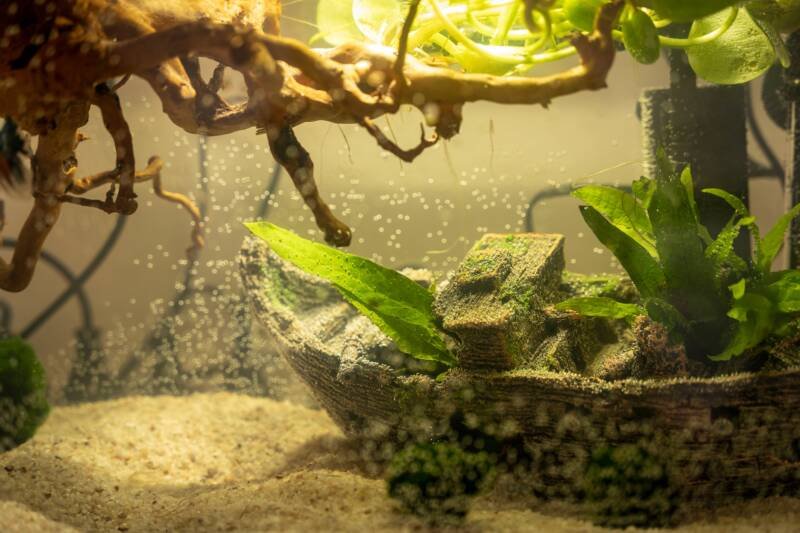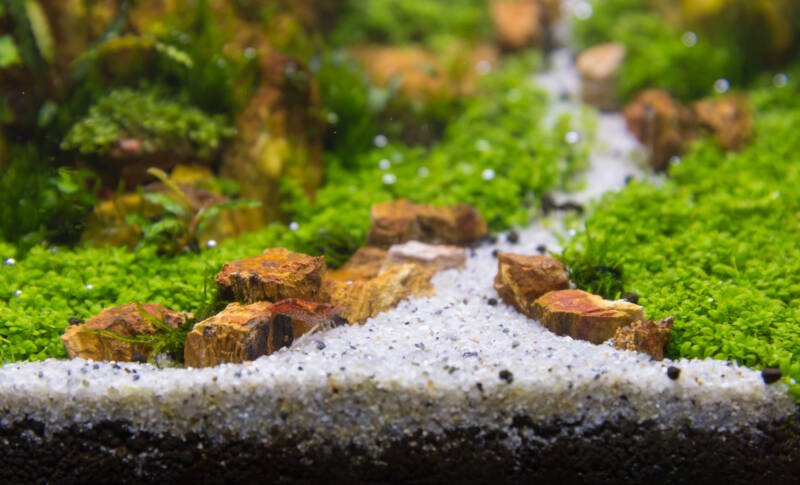It is never a comfortable topic, but it is one that will come up eventually if you keep an aquarium: How to humanely euthanize your fish?
These aquatic creatures become a treasured part of our lives, so when the time comes, we want to send them off without further pain, discomfort, or fear.

In this article
When to Euthanize Your Fish
Know when it is appropriate to euthanize your fish. The following are situations to consider:
- Your fish may have reached an advanced stage in life where their immune system can no longer keep pace with repeat infections or illness.
- A sick fish may have an illness or infection that has progressed to the point where recovery is not possible.
- A young fish may have a condition that is incompatible with life or may result in undue hardship later in life.
It is never acceptable to kill a fish simply because you no longer want it or are able to provide care.
In these cases, always contact your local fish store or find a community group where you can rehome your fish.
How to Humanely Euthanize Your Fish

Research the methods of humanely euthanizing fish and understand the process before attempting it.
The American Veterinary Medical Association (AVMA) notes that non-inhaled, or immersive, anesthetics are commonly used for euthanizing finfish.
However, due to the wide variety of aquatic species, there may be different reactions to the methods employed.
For example, species such as betta fish are highly intolerant of hypoxia or changes in the water oxygen level. When an anesthetic agent is applied, these fish may become agitated and swim erratically.
Nevertheless, the AVMA notes that “the benefits associated with their use (immersive anesthetics) outweigh any distress and aversion they may cause, similar to use of inhaled agents for air-breathing animals.” (AVMA Guidelines for the Euthanasia of Animals: 2020 Edition)
Other species, such as goldfish and cichlids, are hypoxia-tolerant, meaning they can survive for longer durations in low-oxygen environments.
In these cases, an immersion method of euthanasia may not be effective, and a secondary method, such as pithing, may be required.
Fish owners should be aware that any method of euthanasia has the potential to cause distress. The goal is to minimize it.
Consult your veterinarian to determine the best method for your fish.
Veterinarian Option
Many people choose to see their veterinarian when it comes time to put down their pet fish.
Veterinarians have access to a wider range of Drug Enforcement Administration (DEA)-regulated medications and techniques to comfortably euthanize your fish.
Because these are administered by veterinary doctors, you can feel reassured that the process is being done correctly and with minimal discomfort.
This is an especially good option for larger, highly active, or ornamental fish. Factor in the potential for stress caused by transporting your fish to the veterinary office and strive to do so with care.
Home Option
Other people prefer to euthanize their fish at home. In these cases, the immersion of fish in an appropriate anesthetizing agent is by far the most humane method.
Clove Oil
Clove oil is easy to obtain and is a recommended product for anesthetizing fish. In higher concentrations, it can be effective in euthanasia.
Effective dosage will vary depending on the species. The AVMA recommends 17mg/L for anesthesia for some species and a greater concentration of 10 times higher for euthanasia.
To use clove oil, first, fill a smaller container or tank with water matching the conditions of the main fish tank. Keep the lighting as low as possible to reduce stress to the fish.
Mix the oil with water from the fish’s tank before adding it to the container. Use a fine-tipped syringe to disperse the solution. Keep your fish in the solution for at least 10 to 15 minutes after opercular activity ceases.
Note that the FDA prohibits using this method for any fish that have the potential to enter the food chain.
Tricaine Methanesulfonate (MS-222)
For fish intended to enter the food chain, MS-222 is a better solution (pdf). This is the only product approved by the FDA for anesthetizing or euthanizing fish.
You must buffer the solution and be aware that the effective dose will vary depending on the species and their life stage.
The AVMA notes that a concentration of 250 to 500 mg/L, which is 5 to 10 times the anesthetic dosage, will work for most fish species.
As mentioned before, hypoxia-tolerant or larger species may require a secondary method to complete euthanasia.
Stunning/Pithing
This method takes some experience and can be used on its own or in conjunction with one of the immersive methods listed above.
To do it properly, use a blunt object to strike the fish’s head, causing unconsciousness. Quickly afterward, insert a sharp knife into the centerline of the skull just behind the eyes to terminate brain activity.
A similar method involves severing the fish’s head followed by quickly pithing the brain.
Simply severing the head will not be a sufficiently humane method of euthanasia as the brain can retain function for a time following decapitation.
Inhumane Methods to Avoid
You want to avoid any method that causes excessive pain or discomfort to your fish. The following methods are not acceptable for euthanasia.
Boiling Water
Death for your fish, in this case, will not be quick or painless.
CO2 Immersion
This method results in unnecessary stress and takes a long time to kill the fish. As the carbon dioxide is injected into the water, the fish may show signs of distress or hyperactivity.
Flushing
There are many reasons to avoid this method.
First, death of the fish is not necessarily guaranteed. Second, if they do die, this death will be slow and painful as they are exposed to changing water temperature, chemistry, and quality.
In addition, if you flush a sick fish into a system that is closely connected to natural waterways, you can potentially expose these environments to pathogens.
Slow Freezing without Prior Anesthesia
This process takes an extended amount of time and is painful for the fish as ice crystals form on their gills and within their blood.
Leaving Them Out of the Water
This method is cruel. Fish can only breathe oxygen when it is dissolved in water. In air, they will slowly suffocate.
Exposure to Caustic Chemicals
Many such chemicals are regulated by the Environmental Protection Agency (EPA) and cannot be used for off-label applications, such as euthanasia.
In addition, these chemicals can cause unnecessary pain.
Unnecessary or Prolonged Traumatic Injury
Stunning or pithing techniques are best done by someone with experience or under supervision to avoid unnecessary pain for the fish.
Off Label Use of Medications or Chemicals
Certain chemicals are not permitted to be used for euthanasia. Even some that were previously used for such a purpose, such as metomidate, are no longer permitted.
How to Tell if Your Fish is Dead

Use the following to verify that euthanasia has been successful.
Gill Movement
Watch for movement of your fish’s gills, which is called opercular activity.
If you do not detect movement for a minimum of 30 minutes (according to the AVMA), this is a good indication that your fish is dead.
Eye Movement
A conscious fish’s eyes will move when its body is rocked from side to side.
The cessation of this eyeroll, known as the vestibulo-ocular reflex, can indicate that your fish is heavily anesthetized, or when combined with other indicators, it can indicate death.
Body Movement
The cessation of movement, particularly in the presence of a stimulus, can be an indication of death but should not be relied on as the sole indicator.
Heartbeat
The heart of a fish can continue to contract after brain death has occurred, so its immediate cessation is not a reliable indicator of death.
However, if the loss of heartbeat is sustained, then it is likely that death has occurred.
Disposing of the Body
Once you have confirmed that your fish is dead, you need to dispose of the body. This can be done in several ways, depending on your preferences.
Check first to verify any local, state, or federal regulations that impact the method of disposal. The primary concern is human and environmental protection.
Make every effort to prevent the unwanted introduction of pests and disease into the natural environment and to prevent other species from accessing the remains.
Euthanasia must be ensured for early life stage fish to avoid the accidental hatching of potentially invasive species.
Step 1: Remove the dead fish from the tank as soon as possible to prevent degradation of the water due to decomposition of the body.
Step 2: Place the fish in a sealable plastic bag while you prepare for the final step. If you need extra time, you can place the bag in your freezer to delay decomposition.
Step 3: Choose and prepare for your fish’s final resting place using one of the following methods:
Burial
By far one of the gentler methods, burial has the added benefit of being useful for the environment.
Burying your dead fish near trees or in planters provides nutrients to the plants while also providing closure and peace of mind for your family.
Cremation
Many pet owners choose to cremate their dead fish. This must be done in appropriate facilities, such as a pet crematorium. Your veterinarian or a quick online search should help locate one near you.
Disposal
Another idea is to dispose of the body in the trash. Remove the fish from the plastic bag and wrap them in a biodegradable material prior to doing so.
DO NOT Flush Your Fish
You should never flush a dead fish. This method has the potential to release whatever pathogens infected your fish into the environment.
Native fish populations do not have the immune responses necessary to combat exposure to these parasites and bacteria. Consider the potential harm and avoid this method entirely.
Closing Thoughts
The decision to euthanize your pet fish is never an easy one. We form attachments to these animals, and they are important parts of our lives.
As a keeper of aquarium fish, it is important to know when it is appropriate to free your fish from illness or pain in the most humane manner.
Knowing the approved and appropriate methods to euthanize your fish before this action is necessary will save you from last-minute stress and enable you to make the best decision for your pet.
Have you ever had to euthanize one of your fish?
What advice would you give to someone who has never had to do so?